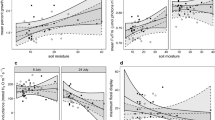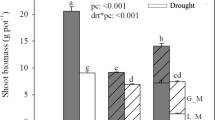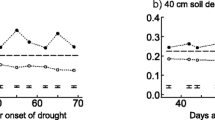Abstract
Plant metabolic activity in arid and semi-arid environments is largely tied to episodic precipitation events or “pulses”. The ability of plants to take up and utilize rain pulses during the growing season in these water-limited ecosystems is determined in part by pulse timing, intensity and amount, and by hydrological properties of the soil that translate precipitation into plant-available soil moisture. We assessed the sensitivity of an invasive woody plant, velvet mesquite (Prosopis velutina Woot.), to large (35 mm) and small (10 mm) isotopically labeled irrigation pulses on two contrasting soil textures (sandy-loam vs. loamy-clay) in semi-desert grassland in southeastern Arizona, USA. Predawn leaf water potential (Ψpd), the isotopic abundance of deuterium in stem water (δD), the abundance of 13C in soluble leaf sugar (δ13C), and percent volumetric soil water content (θv) were measured prior to irrigation and repeatedly for 2 weeks following irrigation. Plant water potential and the percent of pulse water present in the stem xylem indicated that although mesquite trees on both coarse- and fine-textured soils quickly responded to the large irrigation pulse, the magnitude and duration of this response substantially differed between soil textures. After reaching a maximum 4 days after the irrigation, the fraction of pulse water in stem xylem decreased more rapidly on the loamy-clay soil than the sandy-loam soil. Similarly, on both soil textures mesquite significantly responded to the 10-mm pulse. However, the magnitude of this response was substantially greater for mesquite on the sandy-loam soil compared to loamy-clay soil. The relationship between Ψpd and δ13C of leaf-soluble carbohydrates over the pulse period did not differ between plants at the two sites, indicating that differences in photosynthetic response of mesquite trees to the moisture pulses was a function of soil water availability within the rooting zone rather than differences in plant biochemical or physiological constraints. Patterns of resource acquisition by mesquite during the dynamic wetting–drying cycle following rainfall pulses is controlled by a complex interaction between pulse size and soil hydraulic properties. A better understanding of how this interaction affects plant water availability and photosynthetic response is needed to predict how grassland structure and function will respond to climate change.






Similar content being viewed by others
References
Archer SA (1995) Tree-grass dynamics in a Prosopis-thornscrub savanna parkland: reconstructing the past and predicting the future. Ecoscience 2:83–99
Bristow KL, Campbell GS, Calissendorf C (1984) The effects of texture on the resistance to water movement within the rhizosphere. Journal of the Soil Science Society of America 42:657–659
Brugnoli E, Farquhar GD (1998) Photosynthetic fractionation of carbon isotopes. In Photosynthesis: physiology and metabolism, advances in Photosynthesis. In: Leegood RC, Sharkey TD, von Caemmerer (eds) Kluwer Academic Publishers, Dordrecht
Brugnoli E, Hubick KT, von Caemmerer S, Wong SC, Farquhar GD (1988) Correlation between carbon isotope discrimination in leaf starch and carbohydrates of C3 plants and the ratio of intercellular and atmospheric partial pressures of carbon dioxide. Plant Physiology 88:418–1424
Cable DR (1977) Seasonal use of soil water by mature velvet mesquite. Journal of Range Management 30:4–11
Cable DR (1980) Seasonal patterns of soil water recharge and extraction on semidesert ranges. Journal of Range Management 33:9–15
Campbell GS (1985) Soil physics with basic, transport models for soil-plant systems. Elsevier, Amsterdam, Netherlands
Clark MS (1947) The effect of mesquite control on the soil moisture content of mesquite – infested range land in southern Arizona. Tucson AZ, University of Arizona. 36 p. Thesis (This thesis is available on special collection at the UofA library: call number is E 9791 1947 29)
Dawson TE, Ehleringer JR (1991) Streamside trees that do not use stream water. Nature 350:335–337
Dougherty RL, Lauenroth WK, Singh JS (1996) Response of a grassland cactus to frequency and size of rainfall events in a North American shortgrass steppe. Journal of Ecology 84:177–183
Ehleringer JR, Osmond CB (1989) Stable isotopes. In: RW Pearcy, JR Ehleringer, HA Mooney, PW Rundel (eds) Plant physiological ecology: field methods and instrumentation. Chapman & Hall, London, pp 281–300
Ehleringer JR, Phillips SL, Schuster WSF, Sandquist DR (1991) Differential utilization of summer rains by desert plants. Oecologia 88:430–434
Ehleringer JR, Evans RD, Williams D (1998) Assessing sensitivity to change in desert ecosystems –a stable isotope approach. In: Griffiths H (ed) Stable isotope integration of biological, ecological, and geochemical processes. BIOS Scientific Publisher, Oxford, pp 233–237
Flanagan LB, Ehleringer JR, Marshall JD (1992) Differential uptake of summer precipitation among co-occurring trees and shrubs in a pinyon-juniper woodland. Plant Cell Environ 15:15–28
Frasier GW, Cox JR (1994) Water balance in pure stand of Lehmann lovegrass. J Range Manage 47:373–378
Fravolini A, Hultine KR, Koepke DF, Williams DG (2003) The role of soil texture on mesquite water relations and response to summer precipitation. In: Santa Rita experimental range: 100 years of accomplishment and contributions, conference proceedings, 30 October–1 November 2003. Tucson, pp 125–129
Giorgi F, Mearns LO, Shields C, McDaniel L (1998) Regional nested model simulations of present day and 2 × CO2 climate over the central plains of the United States. Climate Change 40:457–493
Golluscio RA, Sala OE, Lauenroth WK (1998) Differential use of large summer rainfall events by shrubs and grasses: a manipulative experiment in the Patagonian steppe. Oecologia 115:17–25
Hacke UE, Sperry JS, Ewers BE, Ellsworth DS, Schafer KVR, Oren R (2000) Influence of soil porosity on water use in Pinus taeda. Oecologia 124:495–505
Hamerlynck EP, Huxman TE, McAuliffe JR, Smith SD (2004). Carbon isotope discrimination and foliar nutrient status of Larrea tridentata (creosote bush) in contrasting Mojave Desert soils. Oecologia 138:210–215
Huxman TE, Cable JM, Ignace DD, Eilts AJ, English NB, Weltzin J, Williams DG (2004) Response of net ecosystem gas exchange to a simulated precipitation pulse in a semi-arid grassland: the role of native versus non-native grasses and soil texture. Oecologia (in press)
Jackson RB, Canadell J, Ehleringer JR, Mooney HA, Sala OE, Schulze ED (1996) A global review of rooting patterns. I. Root distribution by depth for terrestrial biomes. Oecologia 108:389–411
Jackson PC, Meinzer FC, Bustamante M, Goldstein G, Franco A, Rundel PW, Caldas L, Igler E, Causin F (1999) Partitioning of soil water among tree species in a Brazilian Cerrado ecosystem. Tree Physiol 19:717–724
Lauenroth WK, Sala OE, Milchunas DG, Lathrop RW (1987) Root dynamics of Bouteloua gracilis during short term recovery from drought. Funct Ecol 1:117–124
Ledieu, J, Deridder P, DeClerck P, Dautrebande S (1986) A method of measuring soil moisture by time-domain reflectometry. J Hydrol 88:319–328
Lin G, Phillips SL, Ehleringer JR (1996) Monsoonal precipitation responses of shrubs in a cold desert community on the Colorado Plateau. Oecologia 106:8–17
McAuliffe JR (1994) Landscape, soil formation, and ecological patterns and processes in Sonoran Desert bajadas. Ecol Monogr 64:111–148
McClaran MP, Angell DL, Wissler C (2002) Santa Rita experimental range digital database: user’s guide. USFS Forest Service General Technical Report RMRS-GTR-100. Rocky Mountain Research Station, Ogden
McDonald EV, Pierson FB, Flerchinger GN, McFadden LD (1996) Application of a process based soil water balance model to evaluate the influence of Late Quaternary climate change on soil-water movement in calcic soils. Geoderma 74:167–192
McPherson GR (1997) Ecology and management of North American savannas. University of Arizona Press, Tucson
Medina AL (1996) The Santa Rita Experimental Range: history and annotated bibliography (1903–1988). General Technical Report RM-GTR-276. Rocky Mountain Forest and Range Experiment Station, Forest Service, US Department of Agriculture, Tucson
Noy-Meir I (1973) Desert ecosystems: environment and producers. Annu Rev Ecol Syst 4:23–51
Parker KW, Martin SC (1952) The mesquite problem on southern Arizona ranges. US Department of Agriculture Circular 908 70p. Washington DC
Reynolds JF, Virginia RA, Kemp PR, de Soyza AG, Tremmel DC (1999) Impact of drought on desert shrubs: effects of seasonality and degree of resource island development. Ecol Monogr 69:21–24
Risler PD, Wraith JM, Gaber HM (1996) Solute transport under transient flow conditions estimated using time domain reflectometry. Soil Sci Soc Am J 60:1297–1305
Schlesinger WH, Pilmanis AM (1998) Plant-soil interactions in deserts. Biogeochemistry 42:169–187
Schlesinger WH, Reynolds JF, Cunningham GL, Heunneke LF, Jarrell WM, Virginia RA, Whitford WG (1990) Biological feedbacks in global desertification. Science 247:1043–1048
Schulze E-D, Mooney HA, Sala OE, Jobaggy E, Buchmann N, Bauer G, Canadell J, Jackson RB, Loreti J, Osterheld M, Ehleringer JR (1996) Rooting depth, water availability, and vegetation cover along an aridity gradient in Patagonia. Oecologia 108:389–411
Schwinning S, Davis K, Richardson L, Ehleringer JR (2002) Deuterium enriched irrigation indicates different forms of rain use in shrub/grass species of the Colorado Plateau. Oecologia 130:245–255
Schwinning S, Starr BI, Ehleringer JR (2003) Dominant cold desert plants do not partition warm season rainfall by event size. Oecologia 136:252–260
Smith SD, Herr CA, Leary KL, Piorkowski JM (1995) Soil plant water relations in a Mojave Desert mixed shrub community: a comparison of three geomorphic surfaces. J Arid Environ 29:339–351
Snyder KA, Donovan LA, James JJ, Tiller RL, Richards JH (2004) Extensive summer water pulses do not necessarily lead to canopy growth of Great Basin and northern Mojave Desert shrubs. Oecologia (in press)
Sperry JS, Adler FR, Campbell GS, Comstock JP (1998) Limitation of plant water use by rhizosphere and xylem conductance: results from a model. Plant, Cell Environ 21:347–359
Sperry JS, Hacke UG, Oren R, Comstock JP (2002) Water deficits and hydraulic limits to leaf water supply. Plant, Cell Environ 25:251–263
USGC (United State Global Change) (2000) Research report: preparing for a change in climate: the potential consequences of climate variability and change. A report of the Southwest Regional Assessment Group; source: http://www.usgcrp.gov/usgcrp/nacc/sw.htm
Weltzin JF, McPherson GR (1997) Spatial and temporal soil moisture resource partitioning by trees and savannas in a temperate savanna, Arizona. Oecologia 112:156–164
Weltzin JF, Loik ME, Schwinning S, Williams DG, Fay PA, Haddad BM, Harte J, Huxman TE, Knapp AK, Lin G, Pockman WT, Shaw MR, Small EE, Smith MD, Smith SD, Tissue DT, Zak JC (2003) Assessing the response of terrestrial ecosystems to potential changes in precipitation. Bioscience 53:941–952
Williams DG, Ehleringer JR (2000) Intra- and interspecific variation for summer precipitation use in pinyon-juniper woodlands. Ecol Monogr 70:517–537
Yoder CK, Nowak RS (1999) Soil moisture extraction by evergreen and drought-deciduous shrubs in the Mojave Desert during wet and dry years. J Arid Environ 42:81–96
Acknowledgements
We thank Andrea Scartazza (CNR, Porano, Italy) for his indispensable assistance during the carbohydrate extraction and Bill Cable for his assistance in the field. We also thank Mark Larson (University of Wyoming, Laramie, USA) for helping with the carbon isotope analysis. The valuable help of Michael Whitchurch during the manuscript preparation is also acknowledged. Precipitation and temperature data were provided by the SRER database. This study was sponsored by the Student Final Project Fund from the University of Arizona and a USDA-NRI Grant (# 00-35101-9308).
Author information
Authors and Affiliations
Corresponding author
Additional information
Communicated by Jim Ehleringer
Rights and permissions
About this article
Cite this article
Fravolini, A., Hultine, K.R., Brugnoli, E. et al. Precipitation pulse use by an invasive woody legume: the role of soil texture and pulse size. Oecologia 144, 618–627 (2005). https://doi.org/10.1007/s00442-005-0078-4
Received:
Accepted:
Published:
Issue Date:
DOI: https://doi.org/10.1007/s00442-005-0078-4




